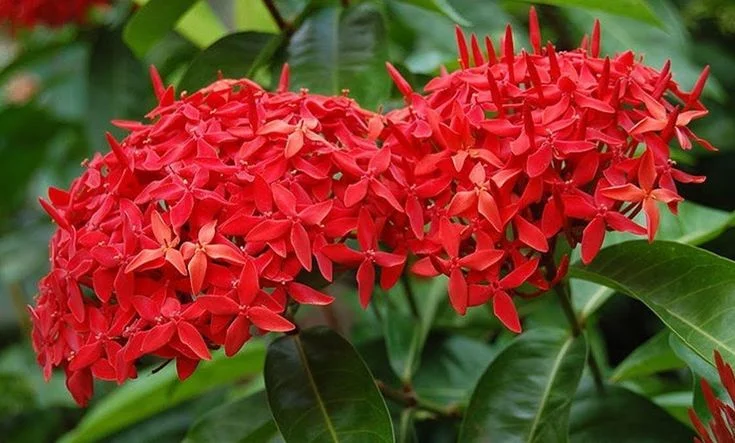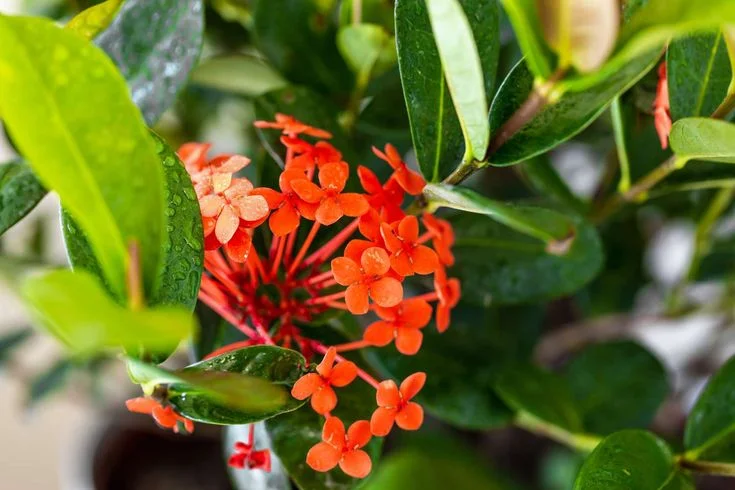The ixora plant fertilizer is one of the most important things you need to ensure your Ixora plants grow beautifully. These stunning tropical shrubs produce bright clusters of flowers in red, orange, yellow, or pink, but they only thrive with the right nutrients.
In this detailed guide, you’ll learn everything about choosing, using, and optimizing the perfect ixora plant fertilizer for stronger roots, greener leaves, and more vibrant blooms.
Understanding the Ixora Plant
Before discussing fertilizers, it’s essential to understand the Ixora plant itself. Naturally, Ixora is a tropical flowering shrub that thrives in warm, humid environments. Typically, it’s grown in gardens and decorative pots because of its lush green leaves and clusters of bright, eye-catching blooms.
Moreover, the plant adds a vibrant, tropical charm to any landscape, making it a favorite among gardeners. However, even though the Ixora plant is relatively hardy, it still requires proper nutrients to flourish. Without regular feeding, the leaves can lose their shine, and the plant may produce fewer flowers.
Consequently, its beauty fades over time, leaving it weak and less appealing. Therefore, it’s vital to maintain consistent care and nourishment. In fact, a well-balanced feeding routine using the right ixora plant fertilizer can completely transform your plant’s health.
As a result, you’ll notice richer foliage, stronger roots, and more vibrant blossoms. Ultimately, when you understand your Ixora’s needs, you can provide exactly what it requires to thrive beautifully throughout the seasons.
Why Ixora Plants Need Fertilizer

Like all plants, Ixoras rely on nutrients from the soil. But over time, those nutrients are used up or washed away by watering and rain. Fertilizers replenish these nutrients, helping the plant grow stronger and healthier.
More importantly, a balanced ixora plant fertilizer supports:
-
Faster root development
-
Rich green foliage
-
Abundant flower production
-
Resistance to diseases and pests
Additionally, fertilizing your Ixora helps it recover quickly after pruning or transplanting.
Best Fertilizer for Ixora Plants
When selecting the best ixora plant fertilizer, go for one that contains a balanced mix of nutrients, especially nitrogen (N), phosphorus (P), and potassium (K). These three are the backbone of plant health.
1. Balanced NPK Ratio
A fertilizer with an NPK ratio of 10-10-10 or 12-12-12 works well. Nitrogen helps with leaf growth, phosphorus promotes root and flower development, and potassium strengthens the overall plant.
2. Acidic Fertilizer
Ixora plants love slightly acidic soil with a pH between 5.0 and 6.0. Therefore, use an acidic fertilizer or add soil acidifiers like sulfur or coffee grounds to maintain the right balance.
3. Slow-Release Fertilizer
Slow-release fertilizers feed your plants gradually, providing a consistent supply of nutrients over time. This method prevents over-fertilizing and helps maintain healthy growth.
4. Organic Options
If you prefer natural choices, compost, fish emulsion, and bone meal make excellent organic ixora plant fertilizers. They not only nourish the plant but also improve soil texture and moisture retention.
How to Apply Ixora Plant Fertilizer

Applying the ixora plant fertilizer correctly is just as crucial as selecting the right one. Proper application ensures your plant absorbs nutrients efficiently and grows stronger. Follow this simple, professional step-by-step guide for the best results.
Water First:
Always water your Ixora plant thoroughly before applying fertilizer. Moist soil prevents fertilizer burn and helps nutrients absorb more effectively into the roots.
Measure Properly:
Use only the recommended amount mentioned on the fertilizer package. Over-fertilizing can damage delicate roots and cause yellowing leaves, so moderation is key.
Even Distribution:
Spread the fertilizer evenly around the base of the plant, keeping it at least a few inches away from the stems and leaves. This prevents direct contact, which could cause leaf burn or root damage.
Water Again:
After applying the fertilizer, water the soil lightly to help the nutrients penetrate deeply. This step also helps distribute the fertilizer evenly throughout the root zone.
Repeat Schedule:
For optimal growth and vibrant blooms, fertilize your Ixora plant every 4–6 weeks during the active growing season typically from spring through early fall. Reduce feeding during cooler months when the plant’s growth slows down.
Common Signs Your Ixora Needs Fertilizer
Even with good care, your Ixora plant may show signs of nutrient deficiency. Watch out for these symptoms:
-
Pale or yellowing leaves
-
Few or no flowers
-
Slow growth
-
Weak stems
If you notice these signs, it’s time to apply your ixora plant fertilizer or adjust the feeding routine.
Best Time to Fertilize Ixora Plants
The best time to feed your Ixora with the right ixora plant fertilizer is during its active growing period from spring through early fall. During this phase, the plant requires additional nutrients to support the development of new leaves and the production of vibrant flowers.
Furthermore, consistent feeding throughout this time ensures stronger roots and continuous blooming. However, as temperatures begin to drop, the plant naturally slows down its growth. In winter, Ixora plants enter a resting phase, conserving their energy.
Therefore, it’s best to reduce fertilization to once every two months or even stop completely until spring returns. This way, your plant avoids nutrient buildup while maintaining a healthy balance. Consequently, when the warmer season arrives, your Ixora will be ready to thrive again with renewed strength and fresh blooms.
Tips for Healthy Ixora Growth
To make the most of your ixora plant fertilizer, follow these helpful tips:
-
Use Rainwater or Filtered Water: Ixora plants prefer slightly acidic water. Tap water may be too alkaline.
-
Prune Regularly: This encourages new growth and more blooms.
-
Provide Full Sunlight: Ixoras need at least 6 hours of sunlight daily.
-
Check Soil pH: Keep the soil slightly acidic for better nutrient absorption.
Additionally, using mulch around the base can help retain moisture and maintain soil temperature.
Natural Fertilizer Alternatives
If you like eco-friendly gardening, there are natural options that work just as effectively as store-bought fertilizers.
-
Compost: Enriches the soil naturally.
-
Banana Peels: Adds potassium for flower growth.
-
Epsom Salt: Improves chlorophyll production and greenness.
-
Coffee Grounds: Helps maintain acidity in the soil.
These organic ixora plant fertilizer alternatives are safe, affordable, and environment-friendly.
Common Fertilizing Mistakes to Avoid

Even the most experienced gardeners can make mistakes when feeding their Ixora plants. Understanding what to avoid ensures your ixora plant fertilizer works effectively and promotes strong, vibrant growth.
For more insights on nourishing other garden favorites, you can also explore this helpful guide on the best fertilizer for Hosta plants. It provides valuable tips that complement your Ixora care routine and help you maintain overall plant health across your garden.
1. Avoid Over-Fertilizing:
Applying too much fertilizer can cause leaf burn and weaken the plant. Always follow the recommended dosage on the fertilizer package to maintain a healthy balance of nutrients.
2. Do Not Fertilize Under Direct Sunlight:
Fertilizing during the hottest part of the day can stress your Ixora plant. Instead, apply fertilizer in the early morning or late afternoon when temperatures are cooler.
3. Never Apply Fertilizer to Dry Soil:
Fertilizing dry soil can harm the roots and reduce nutrient absorption. Always water your plant before applying any fertilizer to protect the roots and enhance nutrient uptake.
4. Maintain Proper Soil pH:
Ixora plants prefer slightly acidic soil. If the soil becomes too alkaline, nutrients become less available, leading to weak growth. Regularly check the pH level to ensure optimal absorption of your ixora plant fertilizer.
By avoiding these common mistakes, you’ll help your Ixora plants flourish and ensure that your fertilizer delivers the best possible results.
FAQs
1. How often should I fertilize Ixora plants?
Fertilize every 4–6 weeks during the growing season. In cooler months, reduce or stop fertilizing.
2. What is the best type of fertilizer for Ixora?
A balanced NPK fertilizer like 10-10-10 or a slow-release acidic fertilizer is best for Ixora.
3. Can I use organic fertilizer on Ixora plants?
Yes, organic options like compost, bone meal, or fish emulsion are great choices for long-term soil health.
4. Why are my Ixora leaves turning yellow?
Yellow leaves often indicate nutrient deficiency or overwatering. Try using an appropriate ixora plant fertilizer and ensure proper drainage.
5. Is Epsom salt good for Ixora?
Yes, Epsom salt adds magnesium, helping the plant maintain lush green leaves.
Conclusion
Feeding your Ixora with the right ixora plant fertilizer can truly transform your garden. Indeed, it’s the difference between having an average-looking plant and a breathtaking tropical display. With proper care, regular feeding, and consistent attention, your Ixora will reward you with dazzling, long-lasting blooms that brighten up any outdoor space.
Moreover, pairing your Ixora with other vibrant blooms can make your garden even more stunning. For more inspiration on what to grow alongside your Ixora, check out this helpful guide on flowers to plant in your garden. It offers practical ideas to create a colorful and balanced landscape that complements your Ixora beautifully.
Ultimately, the key to success lies in consistency and balance. When you provide the right nutrients and seasonal care, your Ixora plants will flourish year after year—bringing color, charm, and tropical elegance to your home garden.
Ultimately, consistency and balance are the keys to success. When you provide the right nutrients in the right way, your Ixora plants will thrive beautifully year after year bringing color, charm, and tropical elegance to your garden.


















